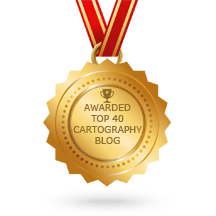Fortune Magazine published an article in 1931, during Prohibition, mapping out the thriving liquor industry of the time. Click the map for full resolution and a full legend.
Despite all the stories about rum-running, imports were much less significant than locally made beverages. Another big factor was "diverted" alcohol. This is alcohol that was produced for industrial purposes but then taken and re-distilled to remove toxins. Distillers posed as varnish, perfume or other chemical makers.
The map shows the regional patterns (easier to see on the full version) of liquor types and import routes. The south and rural areas (the smaller yellow splotches) had thriving local distilleries that created hard liquor from sugar cane, molasses or corn. Beet sugar was popular in Colorado and other western states. There was a large beer belt across the Midwest and into Pennsylvania and New Jersey. Wine* was (and still is) mainly produced in California and the eastern Great Lakes region. The small pink areas are places where smuggling and diverted alcohol predominated, and the green areas in the Northeast were where fruit liquors such as Apple Jack were made.
The little droplets along the Canadian and Mexican borders represent "border seepage."
Despite the picture above less than 3% of all liquor consumed was imported.
The article describes at length the quality of each region's booze heaping praise upon Maryland and Berkeley County, South Carolina while dissing Texas and Kansas.
*Wine had a special status as it is part of religious ceremonies. It was also easy to create from a grape juice concentrate that could be legally transported.
Despite all the stories about rum-running, imports were much less significant than locally made beverages. Another big factor was "diverted" alcohol. This is alcohol that was produced for industrial purposes but then taken and re-distilled to remove toxins. Distillers posed as varnish, perfume or other chemical makers.
The map shows the regional patterns (easier to see on the full version) of liquor types and import routes. The south and rural areas (the smaller yellow splotches) had thriving local distilleries that created hard liquor from sugar cane, molasses or corn. Beet sugar was popular in Colorado and other western states. There was a large beer belt across the Midwest and into Pennsylvania and New Jersey. Wine* was (and still is) mainly produced in California and the eastern Great Lakes region. The small pink areas are places where smuggling and diverted alcohol predominated, and the green areas in the Northeast were where fruit liquors such as Apple Jack were made.
The little droplets along the Canadian and Mexican borders represent "border seepage."
Despite the picture above less than 3% of all liquor consumed was imported.
The article describes at length the quality of each region's booze heaping praise upon Maryland and Berkeley County, South Carolina while dissing Texas and Kansas.
Kansas, though righteous, has bad tastes. It drinks such nauseous home products as “sand-hill rye,” “sugar-moon” whisky, spiked beer, spiked soft drinks, and poorly made home-brew.The full story archive can be seen here. It's long-winded but interesting. The main takeaway is that despite being illegal, the liquor industry of the time was about as normal as any other industry.
*Wine had a special status as it is part of religious ceremonies. It was also easy to create from a grape juice concentrate that could be legally transported.




No comments:
Post a Comment